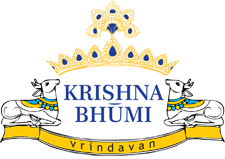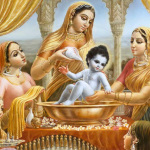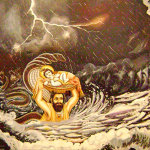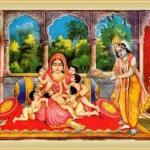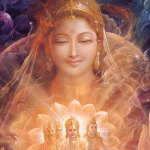Tales of Krishna: victory over Kalia
Kalia was a poisonous snake who lived in the Yamuna River in Vrindavan. Because of this, the river water for four leagues had become unusable. No bird, animal or human was able to use the water. Kalia’s original home happened to be Ramanaka Dwipa, but he had come to reside in Yamuna in Vrindavan for fear of Garuda. Vrindavan was the only place where if Garuda set foot, he would die. Once young Krishna and his group of friends were playing with a ball near the riverbank and the ball accidentally fell into the river.
Without thinking too much about it, Krishna also jumped into the river to get the ball back. Immediately, Kalia rose out of the water and wrapped himself around Krishna’s body. Krishna responded by adopting so huge a form that Kalia had no option but to let him go. The village folk had gathered on the riverbank by this time and were sick with worry. Krishna, not wanting to worry them much longer, jumped on to Kalia’s many heads and started dancing on them. Krishna had assumed the weight of the entire universe; hence Kalia was nearing his end. If it was not for the pleading of Kalia’s wives, Kalia would have surely been killed by Krishna.
However, due to the prayers of the wives, Krishna decided to let Kalia go. Kalia too conceded to Krishna’s mercy and promised to go away and never bother the people of Vrindavan again.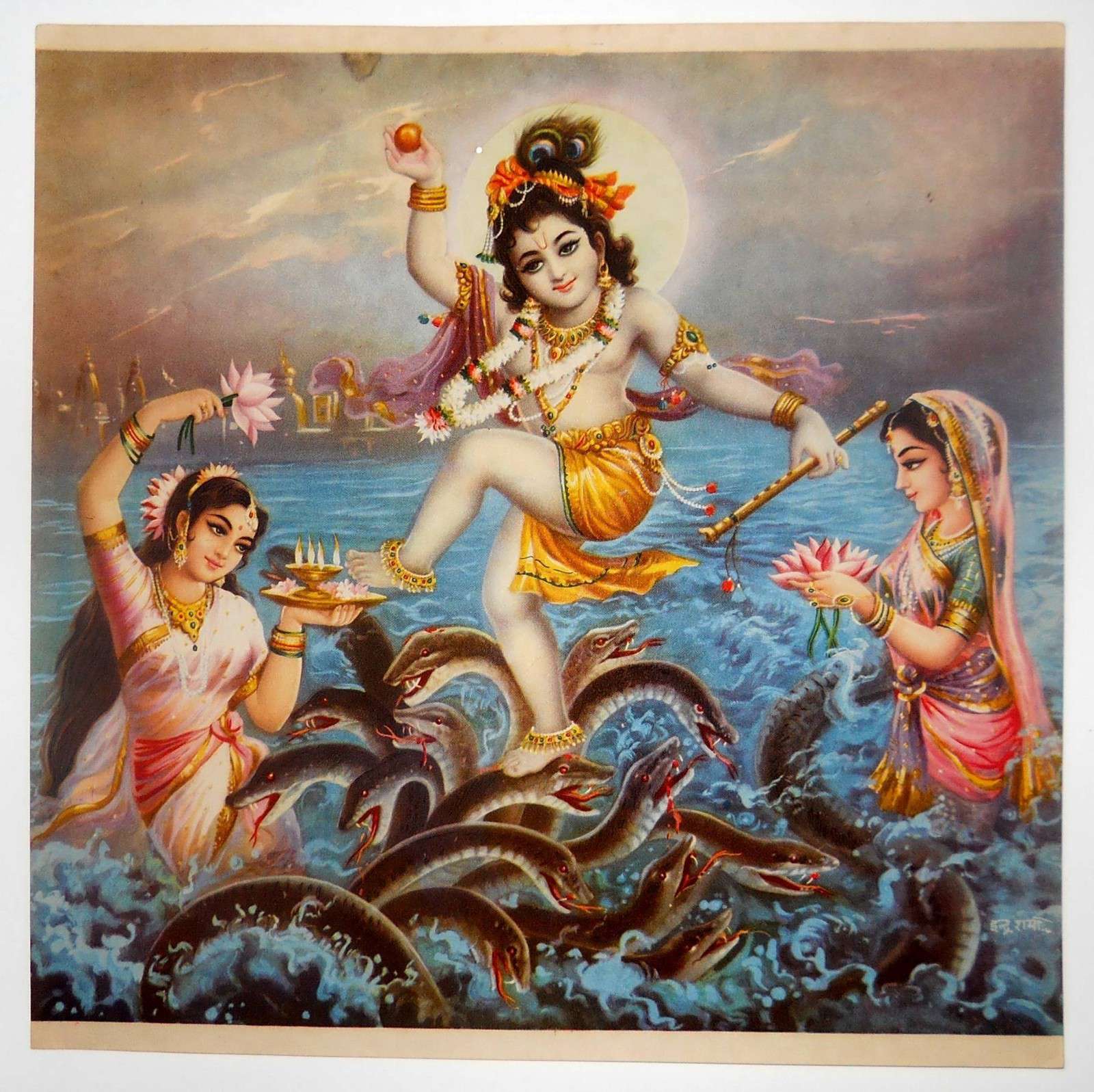
Tales of Krishna: slaying of Kesi
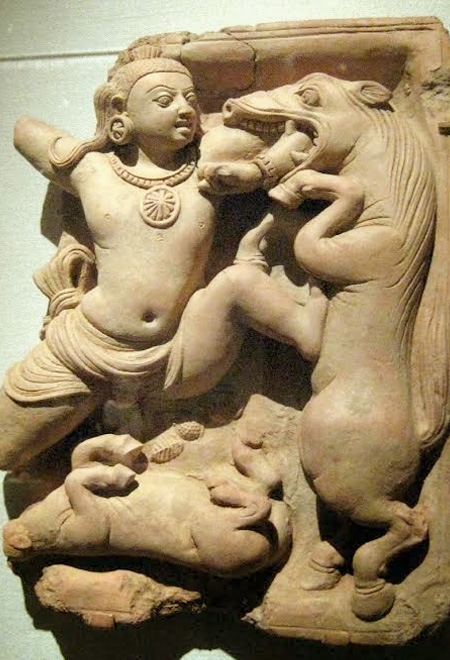 It is true that Vasudev saved infant Krishna from Kansa by taking him from the prison and placing him in Yashoda’s lap. However, as Krishna began to grow up in Gokul, Kansa made more plans of having him killed. He dispatched many demons in disguise to bring about the death of Krishna.
It is true that Vasudev saved infant Krishna from Kansa by taking him from the prison and placing him in Yashoda’s lap. However, as Krishna began to grow up in Gokul, Kansa made more plans of having him killed. He dispatched many demons in disguise to bring about the death of Krishna.
One of these demons was Kesi. Kesi assumed the form of a gigantic horse for the task. He galloped so fast that he could hardly be seen, his hooves touched the ground with such force that the roads cracked. His neighing was terrifying to people.
Kesi went around wreaking havoc in Gokul until Krishna challenged him to a duel. Kesi roared like a lion and charged towards Krishna and struck him with his hooves. Krishna caught hold of his hooves and tossed him to the ground. After this Kesi attacked Krishna by devouring his arm.
However, as soon as Krishna’s hand went inside Kesi’s mouth, all of Kesi’s teeth fell off and Krishna’s arm enlarged in size. Finally, Kesi died a painful death by choking on Krishna’s arm. The Gods and Narad extolled him for this deed and prophesized many other wonderful things that he would go on to do, including putting an end to Kansa and his tyranny.
Krishna Bhumi
Considering that Vrindavan is now excellently connected and is soon developing into an important transition city, it is not a surprise that many residential projects are coming up. Earlier on people could not visit Vrindavan as much they liked due to poor connectivity and not so great accommodation options. However, developers have realized this need of the people and now Vrindavan has become a second home destination for many. One such noteworthy township that is coming up is Krishna Bhumi. What is so unique about Krishna Bhumi that you should choose it over the other options? The other complexes are not built around the tallest Krishna temple in the world.
The makers of Krishna Bhumi understand that Krishna bhakti and luxury and not necessarily concepts that are divorced from each other. This is why they have come up with homes that allow you to enjoy both. Starting from studio apartments to lavish 4000 square feet villas, Krishna Bhumi is envisioned to house the solitary pilgrim as well as the joint Indian family. Whatever the size and whatever the budget, Krishna Bhumi has something for everyone. Our studio apartments start from just 20 lacs after all. Come alone or come with all, but the place you have to come to is Krishna Bhumi.
Krishna and the performing arts
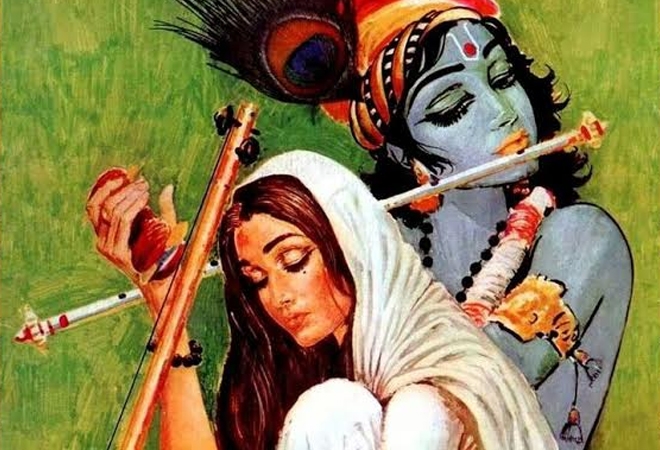 If one is to discuss the origin of theatre in India, then Patanjali’s Mahabhashya cannot be left out. This text was written in 150 B.C and mentions the episode where Krishna slew Kansa and also the episode where he bound Bali Bandha, the titan who was storming the heavens. There are two major Sanskrit plays that have been written on Krishna. ‘Balacharitam’, as the name suggests, deals with the exploits of Krishna when he was a child. ‘Dutavakyam’, on the other hand, focuses on a single episode of the Mahabharata, where Krishna tries to make peace between the Pandavas and the Kauravas and prevent the Kurukshetra war. In the 10th century, the Bhakti saints made sure that Krishna would be remembered in the field of performing arts and composed various folk and classical songs about him that are widely popular even today. Among various dance forms, Odissi and Manipuri draw heavily from Krishna stories. Kathak, which comes from the word ‘katha’, also tells a lot of tales of Krishna in small episodic pieces. The Sattriya dance was founded by a Vaishnava saint and aims at extolling the virtues of Krishna. Yakshagana, a popular style of theater also narrates stories from Krishna’s life that are recorded in the Puranas. Though this style is native to the coastal districts of Karnataka, many performers around the country have started taking it up.
If one is to discuss the origin of theatre in India, then Patanjali’s Mahabhashya cannot be left out. This text was written in 150 B.C and mentions the episode where Krishna slew Kansa and also the episode where he bound Bali Bandha, the titan who was storming the heavens. There are two major Sanskrit plays that have been written on Krishna. ‘Balacharitam’, as the name suggests, deals with the exploits of Krishna when he was a child. ‘Dutavakyam’, on the other hand, focuses on a single episode of the Mahabharata, where Krishna tries to make peace between the Pandavas and the Kauravas and prevent the Kurukshetra war. In the 10th century, the Bhakti saints made sure that Krishna would be remembered in the field of performing arts and composed various folk and classical songs about him that are widely popular even today. Among various dance forms, Odissi and Manipuri draw heavily from Krishna stories. Kathak, which comes from the word ‘katha’, also tells a lot of tales of Krishna in small episodic pieces. The Sattriya dance was founded by a Vaishnava saint and aims at extolling the virtues of Krishna. Yakshagana, a popular style of theater also narrates stories from Krishna’s life that are recorded in the Puranas. Though this style is native to the coastal districts of Karnataka, many performers around the country have started taking it up.
Krishna and the Bhakti Movement
Hinduism is a religion that is not limited to one God. In fact, we have a great pantheon of Gods. Every part of India worships a different deity. Having said that however, the presence of certain figures in our pantheon who unite this diverse nation also cannot be denied. Lord Krishna is one such deity. People from all over the country unite in showering him with love and devotion. Those who have given themselves over to the ecstasy of Krishna worship believe that the Universe is based on the concept of ‘lila’ or ‘divine play’. It is widely known that both Krishna and Rama are avatars of Vishnu. However, while Krishna always believed in expressing his personal love by rising above the boundaries of formal reverence, Rama was known as the epitome of ‘maryada’.
The Bhakti Movement emerged in the medieval period of Hinduism. The point of origin was 7th century Kerala and Tamil Nadu. In the 15th century, this movement started moving towards the east and the north. It peaked between the 15th and the 17th century.
The Bhakti movement encompassed many gods and goddesses. One of these gods was Vishnu. Although Vishnu has many avatars, the believers of the bhakti movement who believed in Vishnu, or the vaishnavas, as they are called, believed Krishna to be the most superior manifestation of Vishnu.
Due to the Bhakti movement, many devotees started feeling like they had an individualistic and personal relationship with Lord Krishna. Perhaps the most cherished Bhakti saint is Meerbai, who considered Lord Krishna to be her lover and husband. Meerabai’s poetry that accentuates her relationship with Krishna and sometimes even hearkens to the relationship that existed between Krishna and Radha, are popular even today.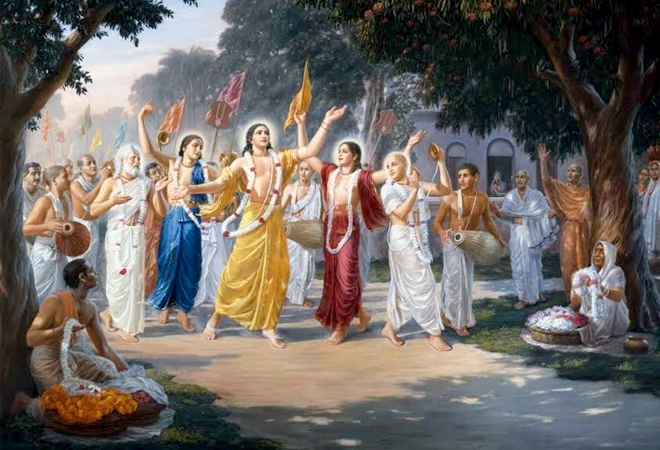
How Krishna wed Rukmini
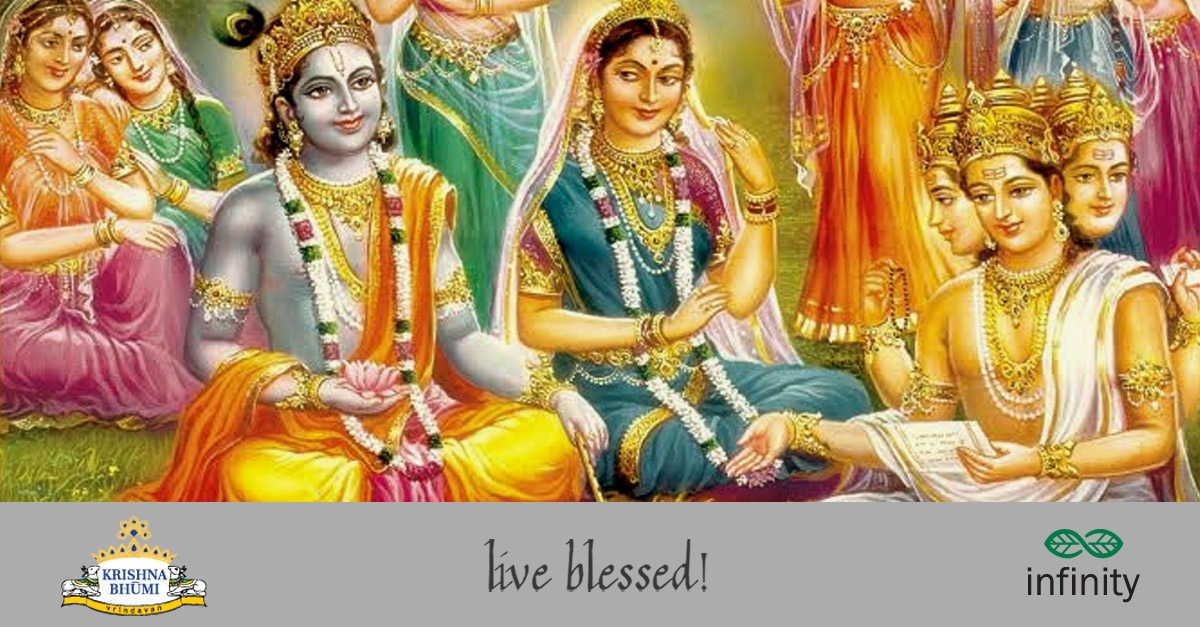 Rukmini was the daughter of the king of Vidarbha, Bhismaka. Bhismaka also happened to be a vassal to Jarasandha, the king of Magadha. As a young girl, Rukmini had fallen in love with Krishna. However, things were complicated as her brother Rukmi had been a friend of Kansa and Kansa had been killed by Krishna.
Rukmini was the daughter of the king of Vidarbha, Bhismaka. Bhismaka also happened to be a vassal to Jarasandha, the king of Magadha. As a young girl, Rukmini had fallen in love with Krishna. However, things were complicated as her brother Rukmi had been a friend of Kansa and Kansa had been killed by Krishna.
Rukmini’s parents were all for Rukmini being married to Krishna but Rukmi, her brother, wanted her to marry Shishupala, the crown prince of Chedi to further his own ambition. Rukmini’s parents finally gave in to this decision but Rukmini herself was horrified at this proposition. She sent a letter to Krishna asking him to kidnap her.
On her way back from the temple, Krishna swept her into his chariot and her wish was fulfilled. However, Rukmi soon caught up with them. There was a duel between him and Krishna. Needless to say, Krishna won the duel. He was about to kill Rukmi when Rukmini fell at his feet and begged him to spare her brother’s life.
Krishna did so but shaved Rukmi’s head so that everyone would know that he was a defeated warrior. Krishna then took Rukmini to a village named Madhavpur Ghed and married her there. There is also a temple at this village that commemorates this day. Rukmini and Krishna married once again in Dwarka with great ceremony and pomp as befitted the King of Dwarka and the princess of Vidarbha.
